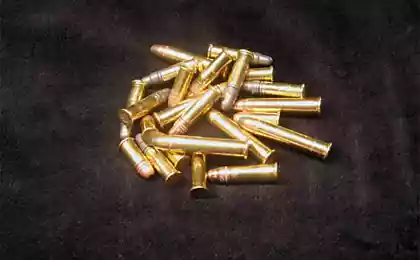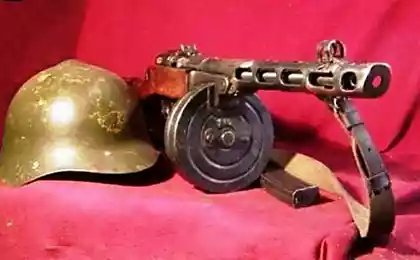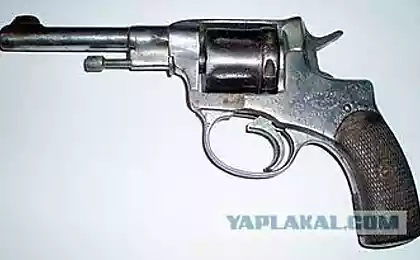1847
Experimental cartridges
Invented in the early XIX century unitary cartridge marked the beginning of the revolution arms business. Under the cut, we look at the original and exotic ammunition.

Caseless and reactive.
Cartridge flying away from the sleeve.
Caseless 9mm cartridge AUPO was developed and tested in the first half of the 1980s, the Italian designer Bruno Chivolani. Especially for the company Benelli Armi munition designed submachine gun Benelli CB-M2.
Cartridge 9mm AUPO consisted of all-metal head and a hollow thin-walled rear, which had the shape of a cylinder
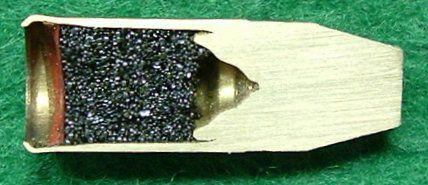
Scheme of the impact mechanism and the device holder pistol gun Benelli CB-M2.
The back of the cartridge, designed as a "cup", served as a sleeve arranged inside the propellant powder charge and arranged in a circle the charge of flammable substances (priming charge). Open the back of the sleeve closed burned down diaphragm, defended the charge of spillage and moisture during storage.

Cartridges with compressed charge.
In the early 60-ies of the last century, the Ministry of Defense of Germany financed the research program for the development and study of intermediate caliber caseless ammunition. Development work conducted by Dynamit Nobel.
From top to bottom: experimental 4, 3h21 DAG and 4, 7h21 DE11, the final 4, 73h33 HK.

Another similar cartridge was developed in the United States AAI Corporation in the early 1980s, for the program «Advanced Infantry Weapon System» (AIWS - promising infantry weapons complex) focused on the search for a replacement for the M-16 rifles.
It was developed a few modifications. The main was the version with 4, 3-mm-piercing bullet with lead core in the drop segment pallet.

Reactive Gyrojet.
Perhaps the most famous circuit diagram of a caseless cartridge jet pistol to the American MBA Gyrojet
Reactive bullets Gyrojet (13 × 50 mm) made of stainless steel have a low initial velocity and stabilize the rotation only by the deviation of the powder gases in the radial plane, but the shot was almost silent, and at a distance of 55 meters the energy to disperse bullets almost doubled higher than the energy of a bullet fired from a pistol Colt M1911.

Underwater active-jet cartridge of caliber 7, 62 mm
In 1967, the Navy ordered TSNIITOCHMASH development of complex underwater weapon for combat swimmers.
Development of the underwater gun and ammunition were launched in February 1968 D. Shiryaev together with SI Matveykin - An engineer in the field of solid-fuel engines. The project is based on an open patent documentation gun Gyrojet.
The cartridge consists of a long steel tube with a sharp tip and heavy. The tube was placed solid fuel block. With the tube closed the bottom nozzle of a jet engine and a steel pallet. As rifling of the barrel rocket led tin lead belt, provides an initial spin bullets. The rocket was mounted in a brass sleeve with expelling charge, and primer "Zhevelo».
The first samples of the gun and ammunition were ready by July 1968 and tested in Feodosia.

One - good, but two - better. Mnogopulnye cartridges.
Bullet SSB (Salvo Squeeze Bore) was first patented in the late 1960s.
SSB is a complex of multiple sub-munitions, hollow conical or conventional bullets that are planted at each other and secured in the sleeve. This design allows to combine submunitions, e.g., the front can be thermostrengthened of steel, and the subsequent - soft copper or with the addition of the tracer composition. SSB has a high stopping power (OD), since affects a large area targets than conventional bullet.

Swept cartridges
According to historical sources arrows tried to charge smoothbore weapons samples back to the 17th century, even those made by hand and placed in a wooden cylinder charges gave some advantage in range of fire.
The peak of research in this area took place in the 60s of the twentieth century. In the USSR, the topic began to engage in the NII-61 (later - TSNIITOCHMASH). The work resulted in a cartridge OPS (feathered Subcaliber shooting) and AO-27 automatic
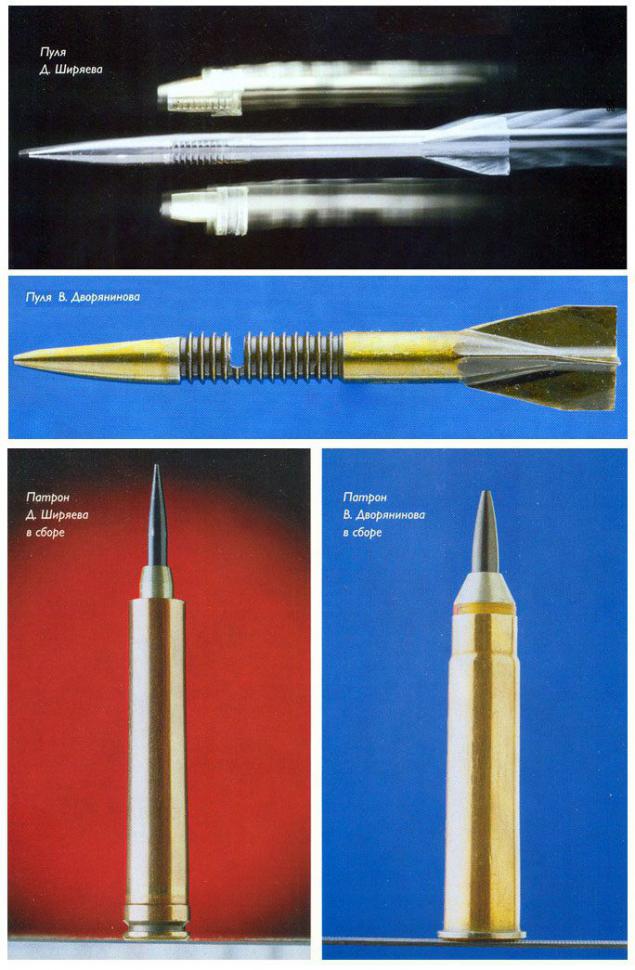
Holders of non-classical layout.
Tround cartridge.
In August 1958, David Dardik patents "firearm with an open chamber» (Dardick open chamber gun) - a hybrid of pistols and revolvers, and the so-called tround cartridge.
It is made of aluminum, and then from high-strength plastic, and was originally available in .38 caliber (9 mm), .30 (7, 62 mm) and .22 (5, 56 mm), its characteristics keeping up patrons 38 SW Special , .32 SW long and .22 LR, and the dimensions of the plastic sleeves of all calibers were the same.
Traund cartridges could re peresnaryazhatsya using standard pistol capsule diameter of 5 mm, and the corresponding caliber bullets. The sleeve had an inner annular groove, limiting planting bullets and providing boost pressure sufficient for complete combustion of gunpowder.

5, 56h36 Folded
In 1965, a design engineer Frankford Arsenal, Andrew Grundy was patented cartridge very unusual shape. A key element of the new concept was a rejection of the classical form of the sleeve with the replacement of its plastic capsule containing the powder charge to the side of the bullet.
This unorthodox configuration cartridge can reduce its size and to implement the scheme of the front combustion of gunpowder charge, reducing the erosive action of powder gases in the bore. Also in theory, decrease the length of the chamber reduces mileage weapons moving parts of weapons that allows for a higher rate of fire at a lower speed of the moving parts, reduce the impact and the mass of weapons.
From 1965 to 1983 cartridges U-shaped tested in various calibers: 4, 32 mm, 5, 56 mm, 7, 62 mm, 12, 7 mm and 30 mm, but never found its army or civilian use.

Cartridge AIWS.
In 1970, Maury Goldin, the designer of the American company Hughes Tool Company, patented design of the cartridge with trёhkamornoy sleeve in the form of the box and the system breechless weapons.
A bullet in the cartridge is located in the central AIWS breech, and the powder charge is placed in the two side of the bolt. This configuration enabled the cartridge storage is 54% more ammo in a given volume than conventional designs with cartridges of the same caliber, as well as significant savings in weight, which was comparable to the advantages offered by the caseless ammunition. At the same time the plastic sleeve provides the necessary obturation powder gases, protecting the propellant and capsule formulation of the environmental impact. Rectangular profile sleeve allows the development of high-capacity magazine and simple in comparison with conventional weapons delivery system cartridge in the chamber and the extraction of spent cartridges.
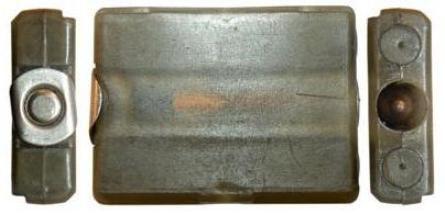
Perforated cartridges
In this category were improvised two types of ammunition.
The first of them - Comp Bullet.
In this pool with the help of high-precision machine is doing several interconnected holes.
When firing a bullet Comp powder gases pass through the bullet holes in the walls and reduce the friction of the rifling of the barrel. According to the assurances of the developers of the holes also play the role of a muzzle brake and reduce the impact of the shot.
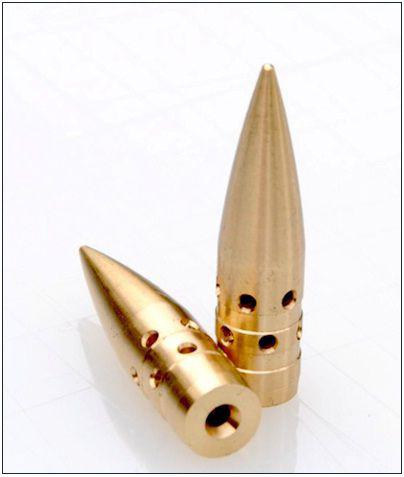
Second ammunition - 7h56 Broadway Trust with a perforated liner.
In 1941, Sir Dennis Bern (Dennis Burney), suggested that the UK Minister of Supply project to develop a portable recoilless anti-tank guns. With the support of the state it was founded a joint company Broad Trust Company (BTC).
Initially, development was carried out in the design of ammunition in the range 20-88 mm. The use of "perforated" liner was to reduce recoil to values allows shooting with it and develop a sufficiently powerful and easy anti ruzhё.Postepenno development focus has shifted to designing smaller caliber guns.

Quiet cartridges
7, 62h63 Snake - one of the special cartridges for silent, flameless fire cutoff of powder gases.
In 50-ies in the NII-61 under the order of the KGB had begun work on the creation of a special doubly silent pistol and ammunition. The complex consisted of a special gun C4 and noiseless cartridge PP (chuck "Snake").

The cartridge 7, 62-mm PP consists of a steel sleeve with a slight taper, inside which there are: the primer KVM 3 in the sleeve with movable hammer (screwed into the bottom of the sleeve and providing obturation powder gases from the capsule), the powder charge mark II -125 and the piston-pusher. The cartridge is armed bullet caliber 7, 62 mm SS.
When fired, the movable cartridge produces drummer prick the capsule, which ignites the powder charge. Pressure powder gases driven by a piston that pushes the bullet in the barrel bore, giving it an initial velocity of flight of 170 m / s. Upon reaching the upper end position, the piston abuts the narrowing walls of the sleeve and stops providing locking powder gases inside the sleeve and quiet shot. Length of cartridge cases from the piston released from it is 82, 3 mm.
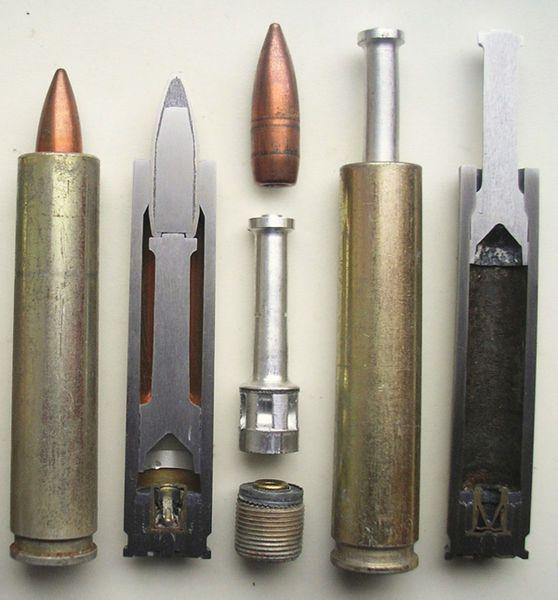
Educational and training ammunition
Wooden chuck 6, 5h55 mm Mauser. Of course, he can not hit the target - a bullet is completely destroyed at the exit from the barrel weapons.
Modern training cartridges are often made of plastic.
Training L14A1 caliber cartridge 7, 62h54 mm with a tracer bullet. This cartridge only collum sleeve and an inner member made from a metal slug.

Plastic bullets used by the military in the exercises on the civilian market, they also are in demand - for recreational shooting. They are loaded with a small charge of gunpowder that makes shooting relatively safe.
The only significant disadvantage of these munitions is that most self-loading rifles and pistols have shall be sent to the next cartridge manually - Automatic due to the reduced sample powder and low mass bullet does not work reliably.

G2R RIP - a new expansive.
By itself, the expansive bullet is not so unusual, but the latest development G2 Research definitely earned his place in this material.
According to the press releases of the small teeth of bullets in flight create a turbulent flow, help to stabilize the bullet and make it more precise, and if it enters as a hole saw cut through clothing, glass, drywall, and even sheet metal, allowing the bottom of the bullets hit the target more confident.
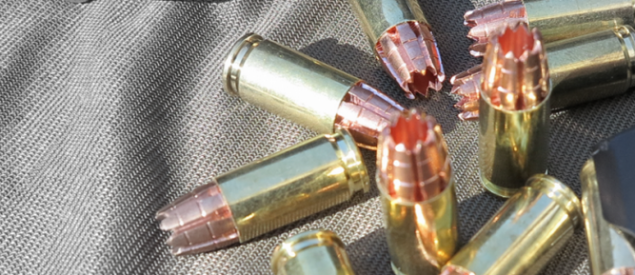
G2R RIP - lead-free, of monolithic bullet weighing 96 Grand Prix is divided into 9 triangular teeth. Muzzle velocity - 386 m \ s. Muzzle energy - 660 J.
G2 Research company soon expects to release ammunition .380 ACP, .357 SIG, .40, .45ACP, and rifle cartridges equipped with a bullet.
The cost of these cartridges reportedly will be about $ 2 apiece. In addition to the high cost of the shortcomings of ammunition include the potential chance of premature disclosure of teeth.

Managed bullet
Product Sandia National Laboratories, demonstrated to the public in November 2011.
At the edge of the bullet is a tiny optical sensor that detects the laser beam, the highlight distant target. The microcomputer processes the sensor signal and rejects miniature plane stabilizers, changing the trajectory. Bullet able to independently adjust the flight of 30 times per second during the entire flight time at a speed of 600 m / s. In flight, the bullet has not stabilize rotation and aerodynamic planes, which allows to precisely target and an optical sensor to control the flight.

Unfortunately, new information about the development at the moment.

Source: www.popmech.ru

Caseless and reactive.
Cartridge flying away from the sleeve.
Caseless 9mm cartridge AUPO was developed and tested in the first half of the 1980s, the Italian designer Bruno Chivolani. Especially for the company Benelli Armi munition designed submachine gun Benelli CB-M2.
Cartridge 9mm AUPO consisted of all-metal head and a hollow thin-walled rear, which had the shape of a cylinder

Scheme of the impact mechanism and the device holder pistol gun Benelli CB-M2.
The back of the cartridge, designed as a "cup", served as a sleeve arranged inside the propellant powder charge and arranged in a circle the charge of flammable substances (priming charge). Open the back of the sleeve closed burned down diaphragm, defended the charge of spillage and moisture during storage.

Cartridges with compressed charge.
In the early 60-ies of the last century, the Ministry of Defense of Germany financed the research program for the development and study of intermediate caliber caseless ammunition. Development work conducted by Dynamit Nobel.
From top to bottom: experimental 4, 3h21 DAG and 4, 7h21 DE11, the final 4, 73h33 HK.

Another similar cartridge was developed in the United States AAI Corporation in the early 1980s, for the program «Advanced Infantry Weapon System» (AIWS - promising infantry weapons complex) focused on the search for a replacement for the M-16 rifles.
It was developed a few modifications. The main was the version with 4, 3-mm-piercing bullet with lead core in the drop segment pallet.

Reactive Gyrojet.
Perhaps the most famous circuit diagram of a caseless cartridge jet pistol to the American MBA Gyrojet
Reactive bullets Gyrojet (13 × 50 mm) made of stainless steel have a low initial velocity and stabilize the rotation only by the deviation of the powder gases in the radial plane, but the shot was almost silent, and at a distance of 55 meters the energy to disperse bullets almost doubled higher than the energy of a bullet fired from a pistol Colt M1911.

Underwater active-jet cartridge of caliber 7, 62 mm
In 1967, the Navy ordered TSNIITOCHMASH development of complex underwater weapon for combat swimmers.
Development of the underwater gun and ammunition were launched in February 1968 D. Shiryaev together with SI Matveykin - An engineer in the field of solid-fuel engines. The project is based on an open patent documentation gun Gyrojet.
The cartridge consists of a long steel tube with a sharp tip and heavy. The tube was placed solid fuel block. With the tube closed the bottom nozzle of a jet engine and a steel pallet. As rifling of the barrel rocket led tin lead belt, provides an initial spin bullets. The rocket was mounted in a brass sleeve with expelling charge, and primer "Zhevelo».
The first samples of the gun and ammunition were ready by July 1968 and tested in Feodosia.

One - good, but two - better. Mnogopulnye cartridges.
Bullet SSB (Salvo Squeeze Bore) was first patented in the late 1960s.
SSB is a complex of multiple sub-munitions, hollow conical or conventional bullets that are planted at each other and secured in the sleeve. This design allows to combine submunitions, e.g., the front can be thermostrengthened of steel, and the subsequent - soft copper or with the addition of the tracer composition. SSB has a high stopping power (OD), since affects a large area targets than conventional bullet.

Swept cartridges
According to historical sources arrows tried to charge smoothbore weapons samples back to the 17th century, even those made by hand and placed in a wooden cylinder charges gave some advantage in range of fire.
The peak of research in this area took place in the 60s of the twentieth century. In the USSR, the topic began to engage in the NII-61 (later - TSNIITOCHMASH). The work resulted in a cartridge OPS (feathered Subcaliber shooting) and AO-27 automatic

Holders of non-classical layout.
Tround cartridge.
In August 1958, David Dardik patents "firearm with an open chamber» (Dardick open chamber gun) - a hybrid of pistols and revolvers, and the so-called tround cartridge.
It is made of aluminum, and then from high-strength plastic, and was originally available in .38 caliber (9 mm), .30 (7, 62 mm) and .22 (5, 56 mm), its characteristics keeping up patrons 38 SW Special , .32 SW long and .22 LR, and the dimensions of the plastic sleeves of all calibers were the same.
Traund cartridges could re peresnaryazhatsya using standard pistol capsule diameter of 5 mm, and the corresponding caliber bullets. The sleeve had an inner annular groove, limiting planting bullets and providing boost pressure sufficient for complete combustion of gunpowder.

5, 56h36 Folded
In 1965, a design engineer Frankford Arsenal, Andrew Grundy was patented cartridge very unusual shape. A key element of the new concept was a rejection of the classical form of the sleeve with the replacement of its plastic capsule containing the powder charge to the side of the bullet.
This unorthodox configuration cartridge can reduce its size and to implement the scheme of the front combustion of gunpowder charge, reducing the erosive action of powder gases in the bore. Also in theory, decrease the length of the chamber reduces mileage weapons moving parts of weapons that allows for a higher rate of fire at a lower speed of the moving parts, reduce the impact and the mass of weapons.
From 1965 to 1983 cartridges U-shaped tested in various calibers: 4, 32 mm, 5, 56 mm, 7, 62 mm, 12, 7 mm and 30 mm, but never found its army or civilian use.

Cartridge AIWS.
In 1970, Maury Goldin, the designer of the American company Hughes Tool Company, patented design of the cartridge with trёhkamornoy sleeve in the form of the box and the system breechless weapons.
A bullet in the cartridge is located in the central AIWS breech, and the powder charge is placed in the two side of the bolt. This configuration enabled the cartridge storage is 54% more ammo in a given volume than conventional designs with cartridges of the same caliber, as well as significant savings in weight, which was comparable to the advantages offered by the caseless ammunition. At the same time the plastic sleeve provides the necessary obturation powder gases, protecting the propellant and capsule formulation of the environmental impact. Rectangular profile sleeve allows the development of high-capacity magazine and simple in comparison with conventional weapons delivery system cartridge in the chamber and the extraction of spent cartridges.

Perforated cartridges
In this category were improvised two types of ammunition.
The first of them - Comp Bullet.
In this pool with the help of high-precision machine is doing several interconnected holes.
When firing a bullet Comp powder gases pass through the bullet holes in the walls and reduce the friction of the rifling of the barrel. According to the assurances of the developers of the holes also play the role of a muzzle brake and reduce the impact of the shot.

Second ammunition - 7h56 Broadway Trust with a perforated liner.
In 1941, Sir Dennis Bern (Dennis Burney), suggested that the UK Minister of Supply project to develop a portable recoilless anti-tank guns. With the support of the state it was founded a joint company Broad Trust Company (BTC).
Initially, development was carried out in the design of ammunition in the range 20-88 mm. The use of "perforated" liner was to reduce recoil to values allows shooting with it and develop a sufficiently powerful and easy anti ruzhё.Postepenno development focus has shifted to designing smaller caliber guns.

Quiet cartridges
7, 62h63 Snake - one of the special cartridges for silent, flameless fire cutoff of powder gases.
In 50-ies in the NII-61 under the order of the KGB had begun work on the creation of a special doubly silent pistol and ammunition. The complex consisted of a special gun C4 and noiseless cartridge PP (chuck "Snake").

The cartridge 7, 62-mm PP consists of a steel sleeve with a slight taper, inside which there are: the primer KVM 3 in the sleeve with movable hammer (screwed into the bottom of the sleeve and providing obturation powder gases from the capsule), the powder charge mark II -125 and the piston-pusher. The cartridge is armed bullet caliber 7, 62 mm SS.
When fired, the movable cartridge produces drummer prick the capsule, which ignites the powder charge. Pressure powder gases driven by a piston that pushes the bullet in the barrel bore, giving it an initial velocity of flight of 170 m / s. Upon reaching the upper end position, the piston abuts the narrowing walls of the sleeve and stops providing locking powder gases inside the sleeve and quiet shot. Length of cartridge cases from the piston released from it is 82, 3 mm.

Educational and training ammunition
Wooden chuck 6, 5h55 mm Mauser. Of course, he can not hit the target - a bullet is completely destroyed at the exit from the barrel weapons.
Modern training cartridges are often made of plastic.
Training L14A1 caliber cartridge 7, 62h54 mm with a tracer bullet. This cartridge only collum sleeve and an inner member made from a metal slug.

Plastic bullets used by the military in the exercises on the civilian market, they also are in demand - for recreational shooting. They are loaded with a small charge of gunpowder that makes shooting relatively safe.
The only significant disadvantage of these munitions is that most self-loading rifles and pistols have shall be sent to the next cartridge manually - Automatic due to the reduced sample powder and low mass bullet does not work reliably.

G2R RIP - a new expansive.
By itself, the expansive bullet is not so unusual, but the latest development G2 Research definitely earned his place in this material.
According to the press releases of the small teeth of bullets in flight create a turbulent flow, help to stabilize the bullet and make it more precise, and if it enters as a hole saw cut through clothing, glass, drywall, and even sheet metal, allowing the bottom of the bullets hit the target more confident.

G2R RIP - lead-free, of monolithic bullet weighing 96 Grand Prix is divided into 9 triangular teeth. Muzzle velocity - 386 m \ s. Muzzle energy - 660 J.
G2 Research company soon expects to release ammunition .380 ACP, .357 SIG, .40, .45ACP, and rifle cartridges equipped with a bullet.
The cost of these cartridges reportedly will be about $ 2 apiece. In addition to the high cost of the shortcomings of ammunition include the potential chance of premature disclosure of teeth.

Managed bullet
Product Sandia National Laboratories, demonstrated to the public in November 2011.
At the edge of the bullet is a tiny optical sensor that detects the laser beam, the highlight distant target. The microcomputer processes the sensor signal and rejects miniature plane stabilizers, changing the trajectory. Bullet able to independently adjust the flight of 30 times per second during the entire flight time at a speed of 600 m / s. In flight, the bullet has not stabilize rotation and aerodynamic planes, which allows to precisely target and an optical sensor to control the flight.

Unfortunately, new information about the development at the moment.

Source: www.popmech.ru



